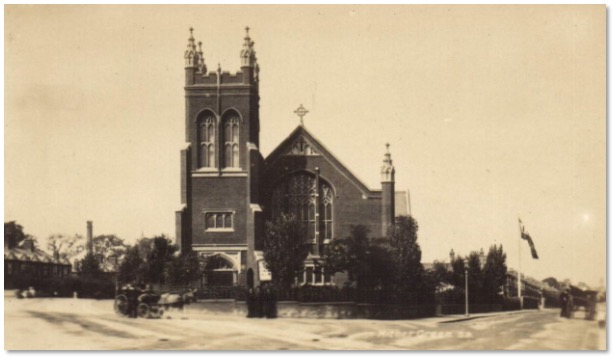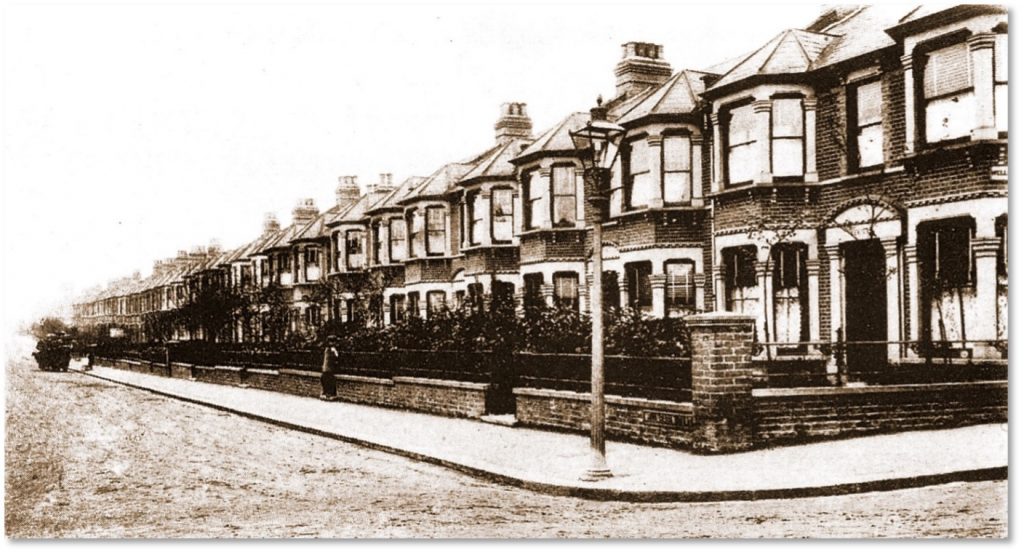“A Germanic Enclave”
Background
Wellmeadow Road was started in 1899 and is the longest of the 27 roads on the Corbett Estate – only Torridon Road is comparable. It runs on even ground from the northern edge of the estate at Duncrievie Road, near Hither Green Station, to Sandhurst Road and then continues uphill to the very southern boundary at Hazelbank Road near Hither Green Cemetery. The 1911 census records returns from 208 houses, which is the fifth largest number of houses on one road. The reason for the smaller than expected number of houses for the length of the street is that the properties themselves are generally quite large: many are double or triple-fronted. This is in stark contrast to some of the more ‘working class’ streets like Sandhurst Road where more people were packed into fewer (and smaller) houses.
Wellmeadow once contained a large complex consisting of a church, a church hall and a school which filled the block between Torridon Road and Hither Green Lane. Unfortunately this received a direct hit from a bomb in 1940; the remaining buildings were demolished in the 1960s and a block of flats now stands in their place. You can find out more about the church in the street profile for Hither Green Lane.

The Wesleyan Church which stood on the corner of Wellmeadow Road and Hither Green Lane until 1940
The Early Residents: details from the 1911 Census
The greatest number of people living in one house is ten, compared with the Estate record of fourteen (living above a shop in Brownhill Road), thirteen living in one house in Sandhurst Road (despite having much smaller houses) and eleven in several other streets. There were also 15 lodgers and 21 visitors staying over on the night of the census.
62 houses had live-in servants, which is 30% of the houses in the road. In Brownhill Road, a much shorter road with some of the largest houses on the estate, 57% of the houses had servants. This compares with 9.5% of houses across the whole estate.
It’s interesting to see from the census returns that the servants who lived in were all female and all but two of them were single. Their ages range from 14 to 62 but half of them were under 21 and more than two-thirds were under 25. It seems likely that they left these jobs and moved out once they married.

An early photo of Wellmeadow Road showing typical double-fronted houses
The occupants of the two houses which each had 10 people living in them were very different. At No. 181 Benjamin Simpson, an Army pensioner born in Worksop, lived with his wife Susan who was born in Holborn. They had three sons and five daughters whose ages ranged from 21 to 7. All eight children are shown as “India Punjab Resident” which indicates that Benjamin served in India for at least 15 years. The older children were all learning trades – apprentices to a civil engineer, a draper and a printer’s engineer.
68 percent of the residents were born in what is now the Greater London area. Despite his surname, Joshua Vanderpump at No. 35 was born in Brixton, which is probably the most unusual one in the street. The oldest resident was Thomas Howell, aged 89 and of private means, who lived with a commercial clerk called Reginald Howell and his wife Zilpah and son Frank at No. 195.
In the tradition of the period, 42 children were named after their mother or father – a confusing practice that is now more evident in the USA than in the UK. The most popular names for adults were William and Mary, followed by Charles and Henry, and Elizabeth and Alice. For children Leslie and Winifred topped the list, with George and William and Marjorie and Ellen coming next.
Residents earned their livings in a variety of ways. Eighteen people are listed as having “private means” but only two of these were male and the others were either single women or widows. A quarter of those in employment are described as clerks and they worked in a wide variety of trades e.g. brewing, a timber merchant, import and export companies, a coffee merchant, the British India Steam Navigation Company and the civil service. Many worked in the clothing industry as milliners, drapers, textile manufacturers, tailors and dressmakers or in other trades as a butcher, fruiterer, gardener, carpenter, gas fitter or printer. The professions are well represented too – civil and mechanical engineers, dentists, teachers and school masters and mistresses, a stockbroker, designers and draughtsmen. There was even a professional singer and a professor of music and these were not common occupations at that time.
Residents from overseas
At No. 90 Wellmeadow Road we find Charles Fuhr and his wife Edith. Charles was a costume manufacturer and “Germany resident” whilst Edith was born in Chippenham. They had two daughters and five sons between 11 and 1 year old, a servant who was born in Cork and a nephew living with them who was also a German resident and worked as a warehouseman. Next door at No. 91 were Emil and Lina Nusser, born in Prussia and Wuerttemberg respectively, and their daughter (born in Prussia) and two lodgers, one of whom came from Prussia. A little Germanic enclave…
A number of other residents in Wellmeadow Road were of overseas origin, including two servants who were originally from Germany and Austria. There was the Van Kregten family from the Netherlands at No. 176, the Meyer family from Germany at No. 212 and Otmar Bertshinger, a clerk born in Switzerland, lived at No. 23 with his Australian born wife Annie from Melbourne. Annie is the resident from furthest away.
Whilst 68% of the people who came to live on the St Germans Estate, as it was first called, came from the Greater London area, there were many residents who were born overseas. Some came from Australia, Canada, South Africa and the USA. Most came from Europe e.g. France, Belgium, Germany (or Prussia), Austria, Switzerland a handful from Russia, Spain, Gibraltar, Malta and Turkey (Constantinople – now Istanbul). They were generally spread out across the whole estate rather than in any particular area, so it is hard to tell whether there was any sense of an overseas community.